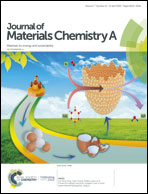A N, S dual doping strategy via electrospinning to prepare hierarchically porous carbon polyhedra embedded carbon nanofibers for flexible supercapacitors†
Abstract
Currently, electrospun carbon nanofibers (ECNFs) have attracted much attention due to their flexibility and easy fabrication. However, ECNFs generally show poor electrical conductivity, greatly limiting their practical application. In this work, flexible hierarchically porous carbon polyhedra embedded carbon nanofibers doped with N and S (NSCPCNF) were synthesized by electrospinning a metal–organic framework ZIF-67 and a thiourea incorporated polyacrylonitrile precursor with subsequent carbonization. Due to the enhanced specific surface area, improved charge transfer ability and pseudocapacitive contribution by N, S dual doping, the as-obtained NSCPCNF shows a much higher specific capacitance of 396 F g−1 at a current density of 1 A g−1 in 1 mol L−1 H2SO4 electrolyte (three-electrode mode) than that of ECNFs (192 F g−1). More importantly, a flexible supercapacitor (FSC) assembled using NSCPCNF electrodes achieves a high specific capacitance of 103 F g−1 at a current density of 0.5 A g−1 (two-electrode mode), and a high energy density of 14.3 W h kg−1 at a power density of 250 W kg−1, which outperforms most of the reported ECNF based FSCs, and it also exhibits a high capacitance retention (107% of the initial value after 3000 charge–discharge cycles) and superior bending stability. The strategy proposed in this work provides the feasibility to explore high-performance flexible electrode materials for FSCs.



 Please wait while we load your content...
Please wait while we load your content...